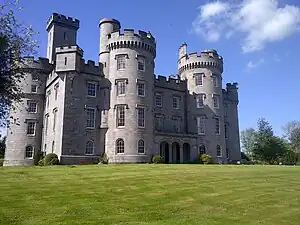Emily Gordon Cathcart
Lady Emily Eliza Steele Gordon Cathcart (née Pringle) was born in 1845. Her father was John Robert Pringle.[1] Her first marriage was to Captain John Gordon in 1865.[2] The natural son of Colonel John Gordon "the richest commoner in the northern kingdom"[3] he had inherited his father's extensive assets, valued at £2-3 million in 1858, on the lower estimate equivalent to £214,000,000 in 2021. The estate included Cluny Castle, North and South Uist, Benbecula and Barra.[4]


When Captain Gordon died without legitimate issue in 1878, Emily Gordon inherited the estates.[1] Her second husband was Sir Reginald Archibald Edward Cathcart (d. 1916) whom she married in late 1880 at St George's Hanover Square, London.[1] He was the sixth baronet of Cathcart, succeeding to the title in 1878. The Cathcart family seat was Killochan Castle near Girvan in Ayrshire but the couple lived mainly in Titness Park, Sunninghill, Berkshire.[4][5][6]
Known for her anti-Catholicism, she played a leading role in the Highland Clearances as she continued the mass evictions initiated by her father-in-law.[7] Many evicted crofters on her lands were forcibly re-settled in Regina and Wapella, in Saskatchewan, Canada, possibly due to the shares she held in the Canadian Pacific Railway.[1]
In 1891 Lady Cathcart commissioned Old Tom Morris to design a golf course at Askernish on South Uist. She included a clause in the crofters tenancy agreements retaining the right to allow golf to be played on the land.[8]
Lady Cathcart never lived in the highlands and is thought to have visited only once;[2] she took ten Vatersay crofters to court in 1908 after they refused to vacate their cottages. They were sentenced to serve two months imprisonment but released two weeks early.
She died on 8 August 1932 at Margate in Kent.[9] Her will included instructions for a Long Island, United States emigration fund to be set up but this was never undertaken as the trustees refused to carry it out for fear of repercussions.[1]
References
Citations
- Ewan, Innes & Reynolds (2006), pp. 139–140.
- Gilchrist, Jim (3 July 2008). "Land and freedom". The Scotsman. Archived from the original on 2 April 2015. Retrieved 28 February 2014. – via HighBeam Research (subscription required)
- "The richest commoner in Scotland". The Times. 23 July 1858. Retrieved 1 December 2013.(subscription required)
- "Gordon of Cluny: the working life of an Aberdeenshire Castle". University of Aberdeen. Archived from the original on 3 December 2013. Retrieved 10 November 2013.
- "Killochan Castle". Discover Ayrshire. Archived from the original on 1 March 2014. Retrieved 27 February 2014.
- Ditchfield, P H; Page, William Page, eds. (1923), "A History of the County of Berkshire", Parishes: Sunninghill, vol. 3, pp. 134–136
- Francis (2006), p. 199
- Owen, David (28 June 2009). "The missing links". The Observer. Archived from the original on 4 September 2015. Retrieved 28 February 2014.
- "Death of Lady Emily Cathcart", Nottingham Evening Post, no. 16880, p. 5, 9 August 1932 – via British Newspaper Archive
Bibliography
- Ewan, Elizabeth; Innes, Sue; Reynolds, Sian (2006), The biographical dictionary of Scottish women: from the earliest times to 2004, Edinburgh University Press, ISBN 9780748617135
- Francis, R. Douglas, ed. (2006), Canada and the British World: Culture, Migration, and Identity, UBC Press, ISBN 978-0-7748-4031-6